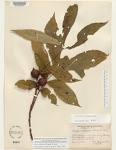Pignut Hickory Tree Information
Images of Pignut Hickory:






Pignut Hickory grows in the following 32 states and provinces:
Alabama, Arkansas, Connecticut, Delaware, Florida, Georgia, Indiana, Iowa, Kansas, Louisiana, Maine, Maryland, Massachusetts, Michigan, Minnesota, Mississippi, Missouri, Nebraska, New Hampshire, New Jersey, New York, Ohio, Oklahoma, Ontario, Pennsylvania, Rhode Island, South Carolina, Texas, Vermont, Virginia, West Virginia, WisconsinInformation about Pignut Hickory:
The Carya Cordiformis is commonly known as the Bitternut, Bitternut Hickory, Pignut Hickory as well as Swamp Hickory.
The currently accepted scientific name for bitternut hickory is Carya cordiformis (Wangenh.) K. Koch . There are no recognized subspecies, varieties, or forms. Bitternut hickory naturally hybridizes with the following : C. illinoensis (C. X brownii Sarg.) C. glabra (C. X demareei Palmer) C. ovata (C. X laneyi Sarg.)Bitternut hickory's range extends from southwestern New Hampshire, Vermont, Maine, and southern Quebec; west to southern Ontario, central Michigan, and northern Minnesota;, and south to eastern Texas and northern Florida. It is most common from southern New England west to Iowa and from southern Michigan south to Kentucky .Some of the information provided here is attributed to:Coladonato, Milo. 1992. Carya cordiformis. In: Fire Effects Information System, [Online]. U.S. Department of Agriculture, Forest Service, Rocky Mountain Research Station, Fire Sciences Laboratory (Producer). , available at the USDA Fire Effects Information System (FEIS) website